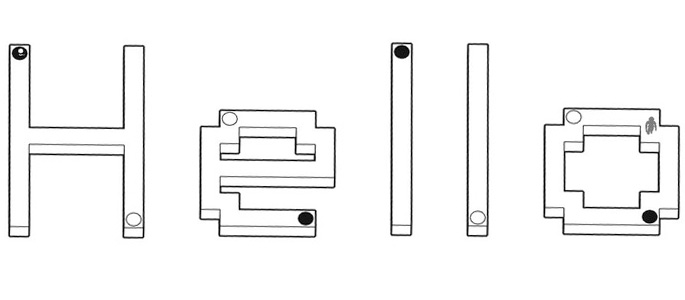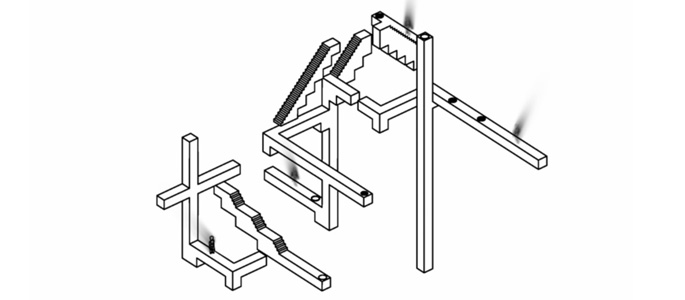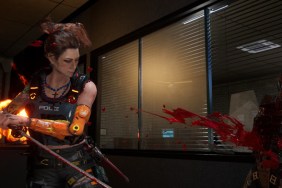
Phil Harrison was onstage at E3 2007 when he first showed off echochrome, a title he described as having “possibly the least graphics and most gameplay.” And I find it hard to disagree with him on those two topics. But despite the innovative gameplay and irresistible aural presentation, there are several glaring problems that end up hampering the overall enjoyment of this title.
Echochrome offers three modes to choose from:
- Atelier is the level select system that allows players to either choose pre-built levels from the developer, or levels that they themselves have built. Atelier includes 56 levels, and shows the recorded stats upfront so that players can immediately determine whether to retry levels, or simply move on to new ones.
- Canvas is the level editor, and is very easy to use. It’s a lot of fun to build levels out of common words, or sculpt them to look like random animals.
- Free Form is the download system for user-generated content. It automatically downloads levels built by fellow echochrome enthusiasts, but does nothing else.

Echochrome is a very innovative game, and benefits from a clean, Escher-like presentation. The graphics are a blend of soft and hard edges; cel-shading in its purest form. The gorgeous classical music, which can be heard in the video preview below, is the most important element as the graphics themselves emote very little. The music ends up elevating the production values, and the intriguing melodies fit very well within the context of Echochrome’s puzzles.
The controls are simple. You adjust the camera angle with the analog stick, and raise the speed of your character’s pace by holding down the X button. The gameplay, however, is not. The goal is to have your character walk through the flickering shadows scattered throughout each level. To do this, you must rotate your point of view to reveal or obscure gaps, jumps, and holes. The jumps are indicated by white circles, and the holes are indicated by black circles.

These three gameplay elements are supplemented by the game’s orthogonal perspective. When your character falls, he doesn’t fall to the bottom of the level. He falls down the screen and lands on the first platform he comes into contact with, regardless if it was technically on the other side of the level. The same rule applies to the jumps, though the jumps are trickier since your character is also propelled forward, as well as up. Remember though, “forward” is a relative term in this game.
Obscuring gaps, jumps, and holes is a vital part of solving these puzzles. You have to rotate the level in such a way that your character can walk across a gap to the next platform. When a piece of the level obscures one of these three items, the game engine assumes that it no longer exists. The holes and jumps will have no effect on the character if you can no longer see them. The gaps between platforms also connect when they are obscured. Think of gaps as their own special objects, rather than just open spaces.

The last feature is both the source of the game’s brilliance, as well as its frustration. Gaps can be eliminated rotating the camera, such that the edges of each gap are overlapping each other. Successful conjoining is indicated when the dividing line between the two platforms disappears, allowing your character the cross the newly formed visual bridge. Very nifty, very cool. But these visual bridges are a little hard to create since the camera moves freely on a pivot, and the lock-on system in place is very weak. Oftentimes, you’ll create a visual bridge for a fraction of a second, only to overshoot the camera and miss an opportunity.
This problem becomes more pronounced when dozens of jumps and holes are placed throughout the levels. What used to be a minor nuisance in the earlier levels (i.e. missing a visual bridge) can escalate into frustrating situations, such as when your character turns back around and falls right through a hole or jumps to his death. The real problems arise when the game engine malfunctions. If you watch the video, you’ll see two examples of when the game notifies you that the visual bridge is complete, but acts as if the gap is still there. I’m actually amazed that the game shipped with such a major flaw. Other various glitches can happen from time to time, such as when your character lands on a new platform.
Your character sometimes keeps his orientation after landing, while other times doing a complete 180 into a jump, a hole, or even the wrong path. It’s good that the character always turns to the left, which keeps things consistent. But the orientation-based errors are just unacceptable. And when your character ends up falling through a platform that he should’ve landed on, expect your hair to start falling out.

There are a lot of levels included, the level editor is a lot of fun to play around with, but echochrome suffers from glitches that unfortunately hold back the level of enjoyment. While innovative and fun to play at first, the game definitely needed more QA testing, and maybe even a design overhaul. If you check out the echochrome arcade game on PlayStation Home, you’ll find that without the ability to hide gaps and create bridges, the gameplay is less frustrating. Hopefully the developer will attempt subtractive design for the sequel, or simply fix the glitches found in their first foray.
PlayStation LifeStyle’s Final Score
Elegant music and good audio work. Collision glitches and graphical errors hurt enjoyability. |
 |





